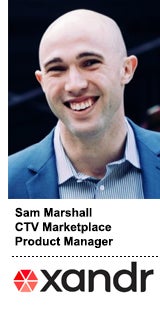This article is sponsored by Xandr.
Recent growth in streaming video viewership around the world has been stunning, leading many advertisers to question how and where to reallocate or complement linear TV budgets, or extend digital display and video into streaming video. But the landscape is rife with confusing acronyms, layers of opaque content licensing and distribution rights and numerous, but distinctly different, paths to the same supply.
As they plan, buyers should have a foundational understanding of the CTV inventory landscape so they can make common sense decisions. My team has put together a glossary to help:
- Over-the-Top or OTT: The overarching term for streaming advertising. OTT encompasses TV everywhere, SVOD and AVOD, which are service types, as well as Connected TV, which is a device type.
- Connected TV or CTV: Connected TV refers to a TV that’s been connected to the internet and can support access to streaming media applications. CTV devices include smart TVs from manufacturers such as Vizio and Samsung, as well as external devices that can be connected to and display content on TVs, such as Roku, Apple TV and Microsoft’s Xbox.
- Advertising-Supported Video On Demand or AVOD:. AVOD services, including Hulu and Tubi, offer on-demand video content to consumers with advertising breaks that allow the service to be free or discounted in price. Available content may be aggregated from multiple sources or proprietary to the service, or both.
- Virtual multichannel video programming distributor or vMVPD: The key word here is “virtual,” as opposed to a non-virtual (i.e., standard) cable TV provider. A vMVPD delivers a bundle of TV content via the internet instead of cable or satellite feeds. vMVPDs (and MVPDs in linear environments) will often have access to a specified number of commercial minutes per hour to sell, negotiated as part of their carriage agreements with broadcast networks. Some vMVPDs include Dish Network’s Sling, AT&T TV Now, and Google’s YouTube TV.
- TV Everywhere (TVE): A streaming service operated by a TV, cable or satellite network—or by an MVPD—that requires users to authenticate their pay TV subscriptions in order to access the content, for example, logging in to your HBO Go account with your Comcast email address. There is not a direct relationship between the consumer and programmer.
- Operating Systems for TVs or devices connected to TV: Similar to mobile phones, smart TVs and CTV devices are powered by operating systems, allowing users to access a variety of owned and third-party services over the internet. In some cases, the owners of these operating systems sell ad space across the relevant services and applications integrated into the platform. Examples are Amazon Fire OS and Roku.
Putting this all together, let’s imagine a buyer wants to advertise on “Conan” on TBS. She has a few options: go directly to TBS, go to a vMVPD with negotiated access to a slice of TBS ad inventory within their own app or TBS’s TVE app or work with a CTV device maker and hope that “Conan” on TBS makes up some part the inventory purchased. Finally, she can use a DSP to access all or most of these entry points to Conan on TBS in OTT and CTV environments simultaneously.
All of the aforementioned access points offer value to buyers, and an effective CTV investment plan could include them all. Therefore, to optimize their CTV inventory sourcing, buyers should be seeking the following from these services and platforms:
Direct paths to premium supply. Most premium CTV inventory is sold directly by publishers, rather than through RTB. The remaining share of inventory is distinctly smaller, so SSPs that provide more direct paths to premium content creators are more likely to deliver scale for buyers.
Direct connection between the DSP and SSP further enhances scale by removing discrepancies and increasing audience match rates.
It’s worth noting that advancements on the sell side, such as Prebid for OTT and more advanced SSP tools, for example, competitive separation and frequency capping, will make it easier for content creators to move more inventory into programmatic marketplaces.
Transparent context. Most premium video buyers have needs around contextual targeting and brand sponsorship. However, as there is not yet an IAB video content taxonomy and no marketplace with a content standard today, buyers generally need to work with publishers directly to enable contextual targeting.
CPMs are generally high for CTV inventory, as it has the perception of being premium across the board. Unfortunately, some available content likely won’t align with a brand’s values or is user-generated. Understanding the full context of placements across content-type, network and show (from publishers or their SSP/DSP) can assure buyers they’re getting real quality.
Effective reach across audiences. The best way to achieve audience at scale is to buy from parties with direct user relationships, whether it be distribution platforms (the vMVPDs) or scaled publishers, such as WarnerMedia and Hulu.
Distribution platforms offer the best reach to users within their ecosystem of programs and applications. Scaled publishers provide reach across a wider set of devices and access points.
Measurement across the above three points. Buyers should know they’ve reached their target audiences, on the desired supply, in the right context. Certain platforms offer insight into pre-campaign (inventory availability, dynamic pricing, data targeting), campaign (tracking performance in flight), and post-campaign data (brand lift, reporting, billing, deal history). However, the depth and availability of this data and contextual information varies by DSP and by SSP, and even by distributor or device type. DSPs and SSPs using the same standards helps.
The general consensus among CTV buyers is that greater consistency both in terms of measurement and audience activation are key to driving more investment, and creating uniform standards is an important factor.

















